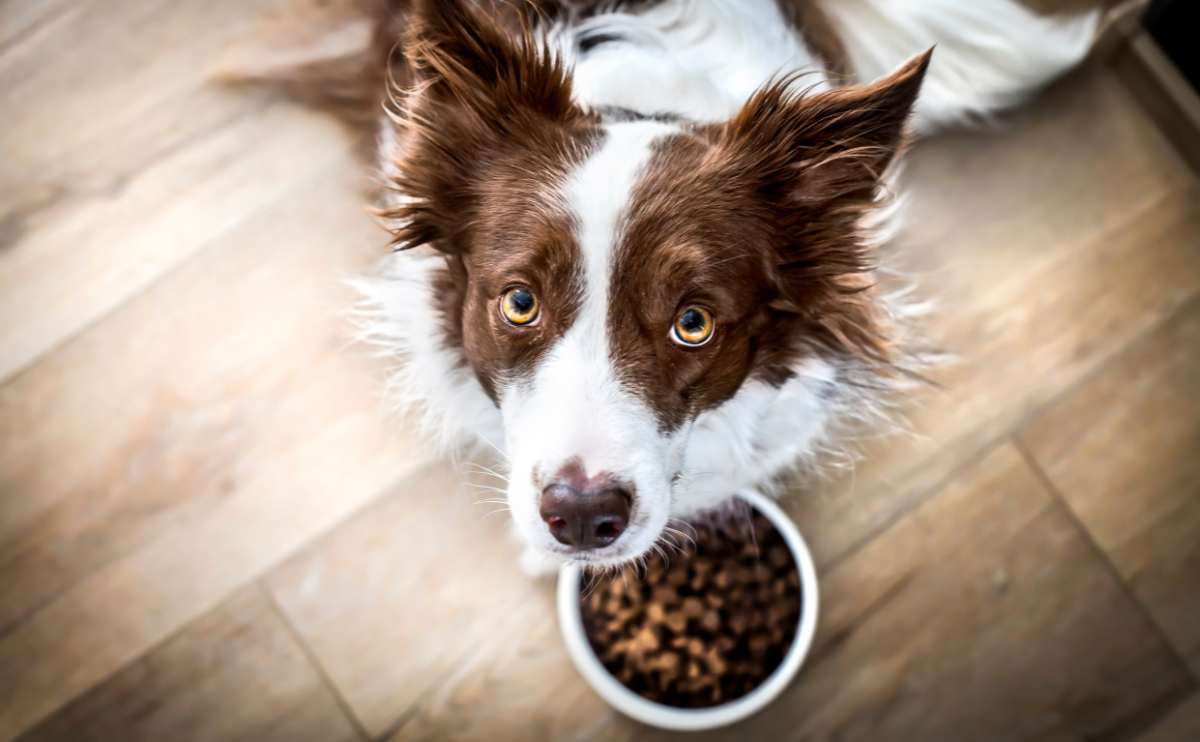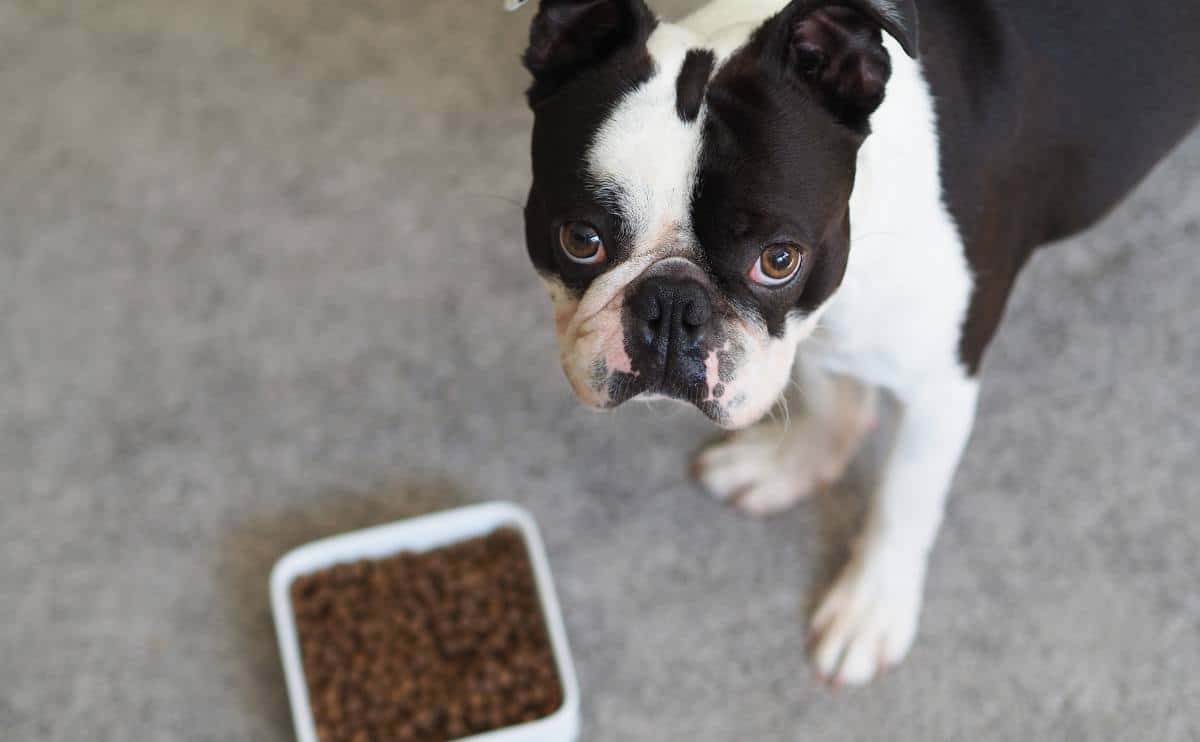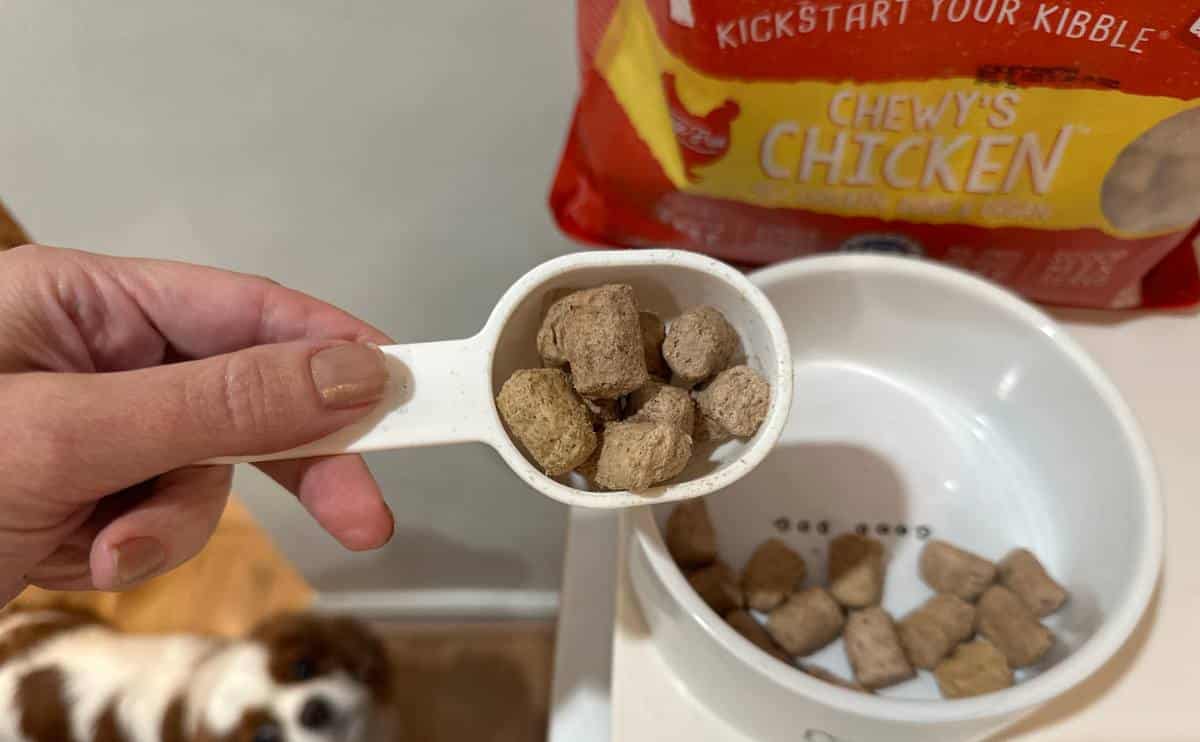This content was reviewed by veterinarian Dr. JoAnna Pendergrass, DVM.
When you purchase through links on our site, we may earn a commission. Here’s how it works.
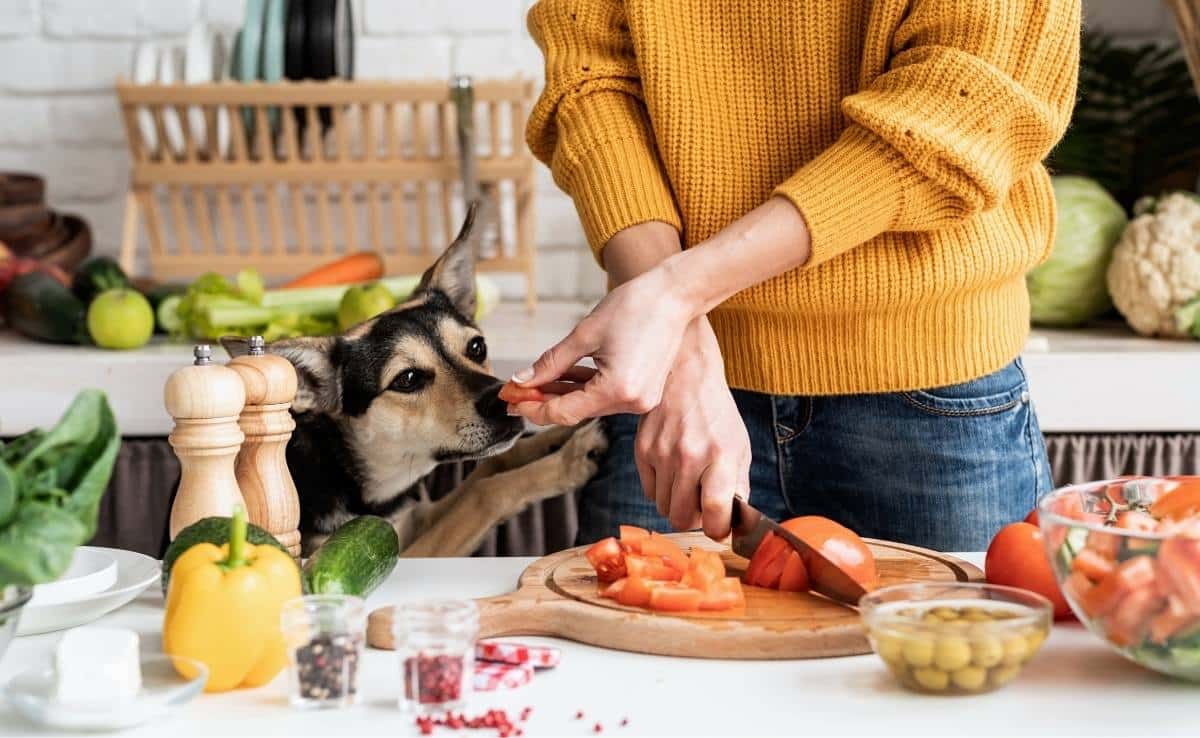
Dogs aren’t picky eaters by any stretch of the imagination. However, this doesn’t mean that everything that they eat is good for them. As a dog parent, you should know how certain foods affect your dog.
All too often, our dogs get into foods they shouldn’t. Some of those foods are toxic to dogs and require immediate vet treatment, which can cost you hundreds or thousands of dollars. If you have pet insurance, accidental poisoning may be covered, which can help save you money and focus on your dog’s health.
But whether you have pet insurance or not, you need to be aware of which foods are unsafe for your dog, so you can keep them safe. We help you by giving you lists of foods dogs can’t eat and some they can eat safely.
- Human Food Is Not Always Dog-Friendly
- Can My Dog Eat That? A List Of Foods Toxic To Dogs
- Infographic: The Menu Of Foods Not To Feed Dogs
- Keep These Foods Out Of Your Dog's Reach As Well
- Keep Your Dog On A Healthy Diet
- Safe Human Foods For Dogs
- Is CBD Safe For Dogs?
- When In Doubt, Ask A Vet
- What If You Can't Reach Your Veterinarian?
- Be Proactive & Save Yourself From Expensive Vet Bills
Human Food Is Not Always Dog-Friendly
Foods that are perfectly suitable for human consumption may be toxic to your dog, posing a serious threat to their health and well-being. Some foods can cause vomiting, diarrhea, upset stomach, weakened breathing, kidney problems, seizures, and even death.
Why? Because a dog’s metabolism is different from our metabolism. Metabolism is the process of breaking down food and turning it into energy. Your dog’s body can’t process all types of food the way your body can, so foods that are just fine for you can be bad news for your dog.
Please note, although we’re attempting to add every food we can find that is potentially unsafe for dogs to this article, there are foods that we may miss. Don’t consider a food safe to feed to your dog just because it’s not on this list of foods bad for dogs.
Do your research if you are uncertain about a particular food. If you are worried about something your pet consumed, please call your vet immediately.
Can My Dog Eat That? A List Of Foods Toxic To Dogs
Here’s an alphabetized list of foods that are unsafe for canine consumption. Be sure to look below this list for a helpful and shareable infographic to print out and keep on your fridge so you know what things dogs can’t eat.
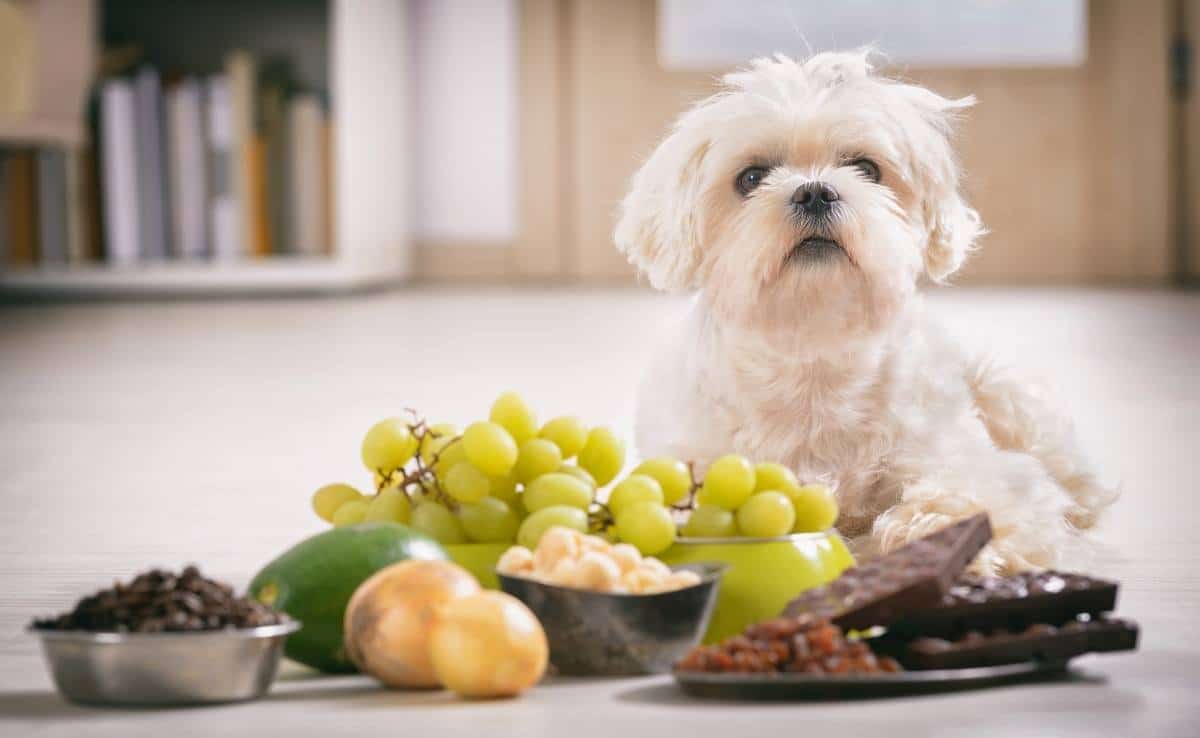
Fruits
Vegetables
Proteins
Pantry Items
Household Staples
Beverages
Miscellaneous
Can Dogs Eat Apple Seeds?
The casing of apple seeds is toxic to a dog because it contains a small amount of natural chemical (amygdalin) that releases cyanide when digested. This becomes an issue if your dog eats a large amount and the seed is chewed up by the dog, causing it to enter the bloodstream. To play it safe, be sure to core and seed apples before you feed them to your dog.
Can Dogs Eat Avocado?
Avocados contain persin, which can cause diarrhea, vomiting, and heart muscle damage. The most dangerous part of an avocado is the pit because it is a choking hazard, and it contains a lot of persin. If you think your dog has ingested an avocado pit, call your vet asap. If your dog ate a small piece of avocado, they should be okay, but make sure you monitor your dog and call your vet for further care.
Can Dogs Eat Grapes & Raisins?
Grapes and raisins can cause kidney failure in dogs. Even a small amount can make a dog ill. Vomiting is an early symptom followed by depression and low energy. We’ve heard stories of dogs dying from only a handful of grapes, so do not feed your pup this potentially toxic food.
Can Dogs Eat Persimmon, Peach & Plum Pits?
Pits and seeds from peaches, plums, and permissions can cause intestinal issues in dogs. Additionally, peach and plum pits have cyanide, which is poisonous to dogs (and people).
Can Dogs Eat Rhubarb & Tomato Leaves?
These contain oxalates, which can cause drooling, vomiting, diarrhea, lethargy, weakness, tremors, and bloody urine.
Is Corn On The Cob Safe For Dogs?
While small amounts of corn are safe for a dog to ingest, giving your dog an ear of corn can be dangerous. If your dog is determined enough (which, let’s face it, most dogs are), they will eat the cob and all. The cob can be a choking hazard and can cause intestinal blockage. This could be fatal to your dog. Learn more in our can dogs eat corn article.
Can Dogs Eat Garlic?
While garlic can be okay for dogs in tiny amounts, more significant amounts can be poisonous. Garlic is related to onions which are toxic for dogs because it kills their red blood cell count, causing anemia. Signs may include weakness, vomiting, and trouble breathing.
Can Dogs Eat Mushrooms
It depends. It’s okay to give a small piece of certain kinds here or there, and each situation is unique given what type of mushroom your dog ate and other factors like your pup’s health. Learn more about mushrooms that are safe and toxic.
Can Dogs Eat Onions & Chives?
No matter what form they’re in (dry, raw, cooked, powder, within other foods), onions are some of the absolute worst foods you could give your pup. They contain disulfides and sulfoxides (thiosulphate), both of which can damage red blood cells and cause anemia.
Can Dogs Eat Almonds?
If a dog eats almonds, it can cause diarrhea, gas, loss of appetite, lethargy, upset stomach, and vomiting. Almonds can also be a choking hazard and can obstruct your dog’s airways. Additionally, almonds can be high in salt and fat, which can cause your dog to retain water and gain weight. Learn more about dogs eating almonds.
Can Dogs Chew On Cooked Bones?
With bones, the danger is that cooked bones can easily splinter when chewed by your dog. However, raw (uncooked) bones are appropriate for both your dog’s nutrition and teeth. Learn more in our dog bone guide. You can also talk with your vet about what types of raw bones would be safe for your dog to chew.
Can Dogs Eat Fat Trimmings?
Cooked and uncooked fat trimmings can cause pancreatitis.
Can Dogs Eat Liver?
Liver can be okay in small amounts but avoid feeding too much to your dog. Liver contains quite a bit of vitamin A, which can adversely affect your pup’s joints and cause gastrointestinal problems.
Can Dogs Eat Raw Meat & Fish?
Raw meat and fish can become contaminated with bacteria, such as E. coli, which can cause food poisoning. Additionally, some fish can contain a parasite that causes “fish disease” or “salmon poisoning disease (SPD).”
Symptoms of food poisoning include vomiting, fever, and enlarged lymph nodes. Cooked, unseasoned fish is perfectly fine because the cooking process kills the parasites. Be sure to remove all bones to avoid choking or internal organ risks.
Feeding raw meat is not recommended because there is a risk of food-borne disease for the dog, as well as the person preparing the food. Although raw diets for dogs are increasing in popularity, organizations like the FDA and American Veterinary Medical Association advise against feeding them.
Can Dogs Eat Chocolate?
Chocolate contains theobromine and caffeine, which speed the heart rate and stimulate the nervous system. The type of chocolate, the amount your dog ingested, and your dog’s weight will determine how sick (or not sick) your dog may become.
Ingesting too much theobromine and caffeine in chocolate may result in vomiting, diarrhea, restlessness, increased urination, tremors, elevated heart rate, seizures, and death. Typically, the darker the chocolate, the more dangerous it is for dogs.
Below is a list of the most to least risky chocolate for dogs:
- Cocoa powder
- Unsweetened baker’s chocolate
- Semisweet chocolate
- Dark chocolate
- Milk chocolate
- White chocolate
Can Dogs Eat Macadamia Nuts?
Ingesting even small amounts of macadamia nuts can be lethal to your dog. Symptoms include muscle shakes, vomiting, increased temperature, and weak back legs. If your dog ingested chocolate with macadamia nuts, the symptoms can be worse.
Can Dogs Eat Popcorn?
The corn itself is fine for dogs to eat, but the hull (the corn seed or kernel) can be dangerous for pets, especially those with smaller throats. The kernel can get stuck between teeth, scrape the throat, or get lodged in your dog’s airway.
Additionally, the toppings you put on popcorn could cause issues for dogs. Salt, butter, and other unhealthy popcorn additives can cause digestive problems, diarrhea, and dehydration. Over time, this could also contribute to kidney damage and obesity.
If you’re interested in sharing your snack, learn how to give your dog popcorn safely.
Can Dogs Eat Salt?
Just like salt isn’t the healthiest thing for humans, it’s even less healthy for dogs. Too much of it can lead to sodium ion poisoning, resulting in symptoms like vomiting, diarrhea, depression, tremors, increased temperature, seizures, and even death.
Can Dogs Eat Sugar?
This applies to any food containing sugar. Make sure you check the ingredient label for human foods – corn syrup (a less expensive form of sugar or glucose) is found in just about everything these days. Too much sugar for your pup can lead to dental issues, obesity, and even diabetes.
Can Dogs Eat Yeast?
Just like yeast rises in bread, it will also expand and rise within your pup’s tummy. Make sure they don’t get any yeast. While mild cases will cause gas, lots of farting, and discomfort, too much yeast could rupture their stomach and intestines. Yeast dough is also dangerous because as it ferments and rises, it releases lots of ethanol into your dog’s bloodstream, which causes alcohol poisoning.
Find out whether dogs can eat bread safely – our experts examine everything from banana bread to rye.
Can Dogs Eat Candy, Chewing Gum, Toothpaste & Mouthwash?
Not only do these items contain sugar, but they often contain xylitol. Xylitol is a sugar alcohol found in gum, candies, baked goods, and other sugar-substituted items. Although xylitol causes no apparent harm to humans, it is highly toxic to dogs. Even small amounts can cause low blood sugar, seizures, liver failure, and even death for your pup. Peanut butter is a common culprit. Always be sure to check the labels for xylitol.
The same plant-derived substance as xylitol is also called “birch sugar” or “birch sap” in ingredient listings. When you’re searching for pet-safe peanut butter or other foods, pay attention to all of these ingredient names.
Can Dogs Eat Human Vitamins?
Giving your dog one of your vitamins or supplements is not recommended. Human vitamin products often contain 100% of the recommended daily amount of various vitamins. This could cause a canine overdose.
The most dangerous vitamin product for dogs is prenatal vitamins, which have a higher iron dose and can cause iron toxicity in pets. If your dog ingests many prenatal vitamins (or other vitamins with a high dosage of iron), you should immediately call your vet. See our reviews of the best vitamins and supplements for dogs.
Can Dogs Drink Alcohol?
Do not give your dog alcohol on purpose. Alcohol can cause not only intoxication, lack of coordination, weak breathing, and abnormal acidity but potentially even coma or death. Find out what dogs can drink safely.
This includes rubbing alcohol and alcohol in hand sanitizers.
When eaten or licked off the paws in large amounts, alcohol-based hand sanitizers can cause digestive upset such as vomiting or can even cause alcohol toxicity if the alcohol content is high enough.
– Elizabeth Racine, Doctor of Veterinary Medicine
Can Dogs Drink Coffee, Tea & Other Caffeinated Beverages?
Caffeine is extremely dangerous to dogs. Within one to two hours, your dog could experience mild to severe hyperactivity, restlessness, vomiting, elevated heart rate, increased blood pressure, tremors, seizures, and death.
Can Dogs Drink Milk & Eat Dairy Products?
While small doses of milk and dairy products are okay for your dog, you could get some smelly farts and nasty cases of diarrhea. This is because dogs become lactose intolerant once weaned off of their mother’s milk. Milk and dairy products can cause digestive problems and could trigger food allergies. Learn more about how dog allergy tests can help you learn about potential health issues.
Can Dogs Eat Cat Food?
Cat food contains proteins and fats that target the diet of a cat, not a dog. The protein and fat levels in cat food are too high for your dog. Ingesting too much cat food can result in an upset stomach, obesity, and pancreatitis.
Can Dogs Have Hops?
Hops are an ingredient in beer that can be toxic to your dog. The consumption of hops by your dog can cause vomiting, panting, increased heart rate, fever, and even death.
Can Dogs Eat Marijuana?
Marijuana contains THC, a psychoactive chemical that causes a ‘high’ in people. Just a small amount of marijuana can be toxic to dogs. Here are the common symptoms of marijuana toxicity in dogs: slow response times, dribbling urine, heart rate change, neurological stimulation, hyperactivity, coma, and even death. Read more about dogs and marijuana.
Can Dogs Eat Tobacco?
Tobacco contains nicotine, which can be lethal to dogs. Symptoms include vomiting, abnormal heart rate, tremors, and weakness. Tobacco poisoning can present itself within one hour of ingestion.
Infographic: The Menu Of Foods Not To Feed Dogs
Here’s a “menu” of things your dog should never eat.

Keep These Foods Out Of Your Dog’s Reach As Well
While these foods don’t fall in a particular category above, you’ll want to avoid them as well.
Old Food
You don’t like old and moldy food, so what makes you think your dog will? The bacteria in spoiled food contains all sorts of toxins that can be damaging to your dog’s health. Feed your dog only the freshest and best dog food.
Leftovers
If you feed your dog leftovers regularly, they won’t get a proper diet. Plus, those leftovers can be high in fat and calories, causing your dog to pack on too much weight. If you decide to give your dog table scraps, make sure to remove any bones and trim down the fat.
Human Snacks
Chips can contain garlic and onion powder, and cookies may contain raisins, chocolate, macadamia nuts, etc. Bottom line — there’s a reason there are food and treats made especially for dogs.
Keep Your Dog On A Healthy Diet
Choosing to raise a dog is a big responsibility. Just as with a child, you’ve welcomed another living being into your household and family. We probably don’t have to tell you to take care of your dog, but your dog will have very different needs from your child regarding food.
Ask your veterinarian what kind of food would be best for your dog, given your dog’s size, age, and any special health needs. That way, you know what your dog can eat, and you’re less likely to have any food-related issues.
Safe Human Foods For Dogs

While many human foods are safe to feed your dog, many are unsafe. As a general rule of thumb, it is far better to be safe than sorry. Avoid feeding your dog any human food unless advised to do so by your vet.
By not feeding your dog human food or table scraps, you’re training your dog to not beg for them in the first place, paving the way for acceptable ‘food manners.’ Those good manners will mean that they’ll bother visitors less frequently at mealtime.
Below is a list of human foods that are safe for dogs to eat in moderation.
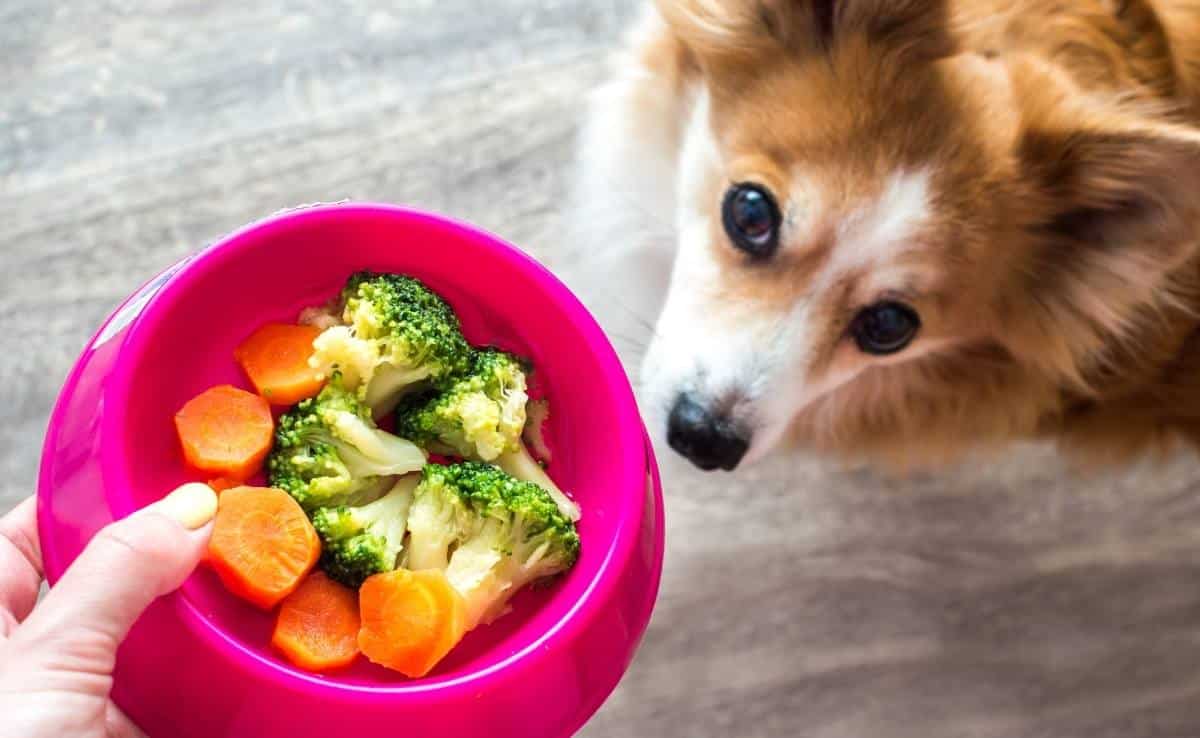
Fruits
- Apple Slices
- Bananas
- Blueberries
- Cantaloupe
- Cranberries
- Mangoes
- Oranges
- Peaches
- Pears
- Peas
- Pineapples
- Raspberries
- Strawberries
- Watermelon
Vegetables
- Broccoli
- Brussels Sprouts
- Carrots
- Celery
- Cooked Potatoes
- Cucumber
- Green Beans
- Peppers
- Spinach
- Sweet Potatoes
Proteins
Grains
Can Dogs Eat Apple Slices?
Apple slices are safe for your dog to eat and are a great source of fiber and carbohydrates. But be sure to remove the seeds because they’re not safe for dogs.
Can Dogs Eat Bananas?
Bananas can be a yummy and healthy treat for your dog to eat. Just be sure to peel the banana before letting your dog have it. The banana peel isn’t toxic to your dog, but it can be challenging to digest and could cause intestinal blockage issues.
And remember to give your dog bananas in moderation. Too much could cause an upset tummy.
Can Dogs Eat Blueberries?
Blueberries can be a great low-calorie treat option for your dog. Blueberries contain antioxidants, fiber, and vitamins C and K, all of which help your dog’s overall health. You could use blueberries as a training treat if you’d like.
Can Dogs Eat Cantaloupe?
Cantaloupe is a great treat alternative for overweight dogs. You may want to remove the seeds, though, because they can be a choking hazard for your dog.
Can Dogs Eat Cranberries?
Cranberries and dried cranberries are safe for your dog to eat in small quantities. However, your dog may not be a fan of tart fruit. If you find that your dog likes cranberries, feed them in moderation to prevent an upset tummy.
Can Dogs Eat Mangoes?
Yes, mangoes are safe for dogs to eat. Just make sure you remove the skin beforehand. While the skin isn’t technically toxic to your dog, it can be difficult to digest, and your dog could choke on it. Remove the pit as well because it contains cyanide, which is toxic to dogs.
Can Dogs Eat Oranges?
Yes, dogs can eat the flesh of an orange. But be sure to remove any seeds and the peel before giving your dog any oranges.
Can Dogs Eat Peaches?
Peaches are a safe fruit for your dog to eat. Peaches are full of vitamins A and C, antioxidants, fiber, and more. However, peach pits can be poisonous to dogs. Peaches are higher in sugar, so it’s best only to give this food in small amounts.
Can Dogs Eat Pears?
Yes, dogs can eat pears. Pears have many nutritional qualities, including vitamins C and K, fiber, and copper. Like many other fruits, you should remove the seeds because they can contain traces of cyanide, which is toxic to dogs.
Can Dogs Eat Pineapples?
Pineapple is safe for your dog to eat. It has many vitamins and minerals, which can help boost your dog’s immune system and digestive health. However, pineapple is high in sugar, so moderation is key. If you’d like to learn more about safely giving your dog pineapple, read our can dogs eat pineapple article.
Can Dogs Eat Raspberries?
Yes, your dog can eat raspberries but only in moderation. Too many raspberries could cause your dog to experience some gastrointestinal (GI) problems like vomiting, diarrhea, and constipation.
Can Dogs Eat Strawberries?
Strawberries are safe for dogs to eat. But feed your dog strawberries in moderation. Strawberries are high in natural sugar, which isn’t beneficial for dogs and can cause GI issues.
Can Dogs Eat Watermelon?
Yes, your dog can eat watermelon, but the seeds can cause intestinal blockage, so it’s best to give seedless watermelon or remove the seeds. Don’t give your dog the watermelon rind to chew on, as it can cause GI problems.
Can Dogs Eat Broccoli?
Broccoli is a safe vegetable for your dog to eat and can be nutritious. Give a small amount first to avoid upsetting your dog’s stomach.
Can Dogs Eat Brussels Sprouts?
Brussels sprouts are safe for your dog to eat, but you may want to avoid including them in their diet because they can cause flatulence. While your dog’s gas may not be harmful to him, it may cause you to leave the room.
Can Dogs Eat Carrots?
Carrots (cooked or raw) are a great low-calorie snack and can be a useful training tool. In fact, you can give your dog slices of carrots as a treat and a healthier alternative to other training treats. Stay away from canned or pickled carrots because they contain too much salt.
Can Dogs Eat Celery?
Celery is safe for dogs to eat, but it should be cut into smaller pieces or cooked to help soften it and prevent choking. If you’d like to start giving your dog celery, we have tips on feeding celery to your dog in our can dogs eat celery article.
Can Dogs Eat Cooked Potatoes?
Raw potatoes aren’t safe for dogs because they contain solanine which can be toxic to dogs and difficult to digest. However, cooked, unseasoned potatoes are perfectly safe for dogs to eat. Learn more in our can dogs eat potatoes article.
Can Dogs Eat Cucumber?
Cucumber slices can be a healthy snack for your dog. Your dog may like the crunch it offers, which can be similar to other dog treats. Cucumbers are low-calorie, so they may be a good snack for overweight dogs.
Can Dogs Eat Green Beans?
You can give your dog raw, steamed, or canned green beans as long as they are plain (leave the salt and other seasonings off). Vets often recommend green beans as a healthy treat option for dogs.
Can Dogs Eat Peppers?
Bell peppers are okay to feed dogs. Dogs are carnivores and prefer meat to vegetables, but there are some benefits to veggies. For example, green peppers are a low-calorie snack packed with vitamin C and beta-carotene.
Be sure to chop peppers into small pieces because the outer skin can be tough and difficult to chew. Pureeing or steaming the peppers makes them easier to consume and digest. As with most human food, don’t overdo it because too much could lead to sickness. Never give your dog a spicy variety such as jalapeños or hot peppers.
Can Dogs Eat Peas?
Green peas, snow peas, garden peas, and sugar snap peas are all safe for your dog to eat. Peas can be given to your dog fresh, frozen, or thawed, but you should avoid canned peas because they can often have high amounts of sodium in them.
Can Dogs Eat Spinach?
Spinach is okay for your dog to eat. However, it’s high in oxalic acid, which can lead to kidney damage. So while your dog can safely eat spinach, you won’t want them to make a habit of eating it.
Can Dogs Eat Sweet Potatoes?
Dogs can eat cooked, unseasoned, peeled sweet potatoes. The skin can be difficult for your dog to digest, and you should never feed your dog raw potatoes of any sort.
Can Dogs Eat Eggs?
Salmonella poisoning and biotin deficiency are two things to be cautious of when feeding your dog raw eggs. It is safest to give your dog a cooked egg over a raw egg. Eggs are an excellent source of protein and have a host of vitamins for your pup. Don’t cook eggs in butter, oil, salt, pepper, or other additives; dogs don’t need those things, and they can be harmful to them as well.
Can Dogs Eat Hot Dogs?
Most hot dogs made from beef, chicken, pork, or turkey are safe for dogs. However, it depends on the hot dog ingredients and your dog’s food allergies and intolerances. Plant-based hot dogs are generally safe for dogs to eat. Ultimately, remember to read the instructions carefully so you know if your dog can eat hot dogs.
Can Dogs Eat Lean Meat?
Lean meat includes the white, boneless meat from chicken or turkey and has had excessive fat removed. It provides a tasty treat for your dog and serves as a great source of protein. If feeding chicken and turkey, remove the fatty skin and cook or boil the meat without seasoning. Learn more about feeding turkey to dogs.
Can Dogs Eat White Rice?
Cooked white rice is a common recommendation for a dog with an upset stomach. Generally, boiled white chicken and white rice helps firm up stools and nourish a dog that is having trouble getting any nutrition from food as a result of illness.
Human-Grade, Fresh Dog Food
While not exactly human food, there are fresh, human-grade dog foods available for delivery to your doorstep. Our favorite is The Farmer’s Dog if you want to check out our first-hand review to learn more.
Visit The Farmer’s Dog Website
Is CBD Safe For Dogs?
CBD (cannabidiol) may be a natural way to treat anxiety, pain, skin conditions, neurological disorders, and more. But is it effective and safe for dogs?
From the limited veterinary research performed so far, reports show that CBD is safe and effective for managing arthritis in many dogs. More research needs to be done to evaluate how CBD could help with other conditions in dogs, such as seizures.
Be sure to choose a high-quality product from a reputable manufacturer. Many companies are joining the CBD hype, so the CBD product at the best price may not be the safest for your pup. Do your research before you get started.
Also, your vet understands your dog’s unique needs better than you or the company selling the products, so be sure to check with them before administering. Be aware, though, that your vet is not legally allowed to recommend CBD treatment for your dog.
Learn More About The Benefits Of CBD Oil For Dogs
When In Doubt, Ask A Vet
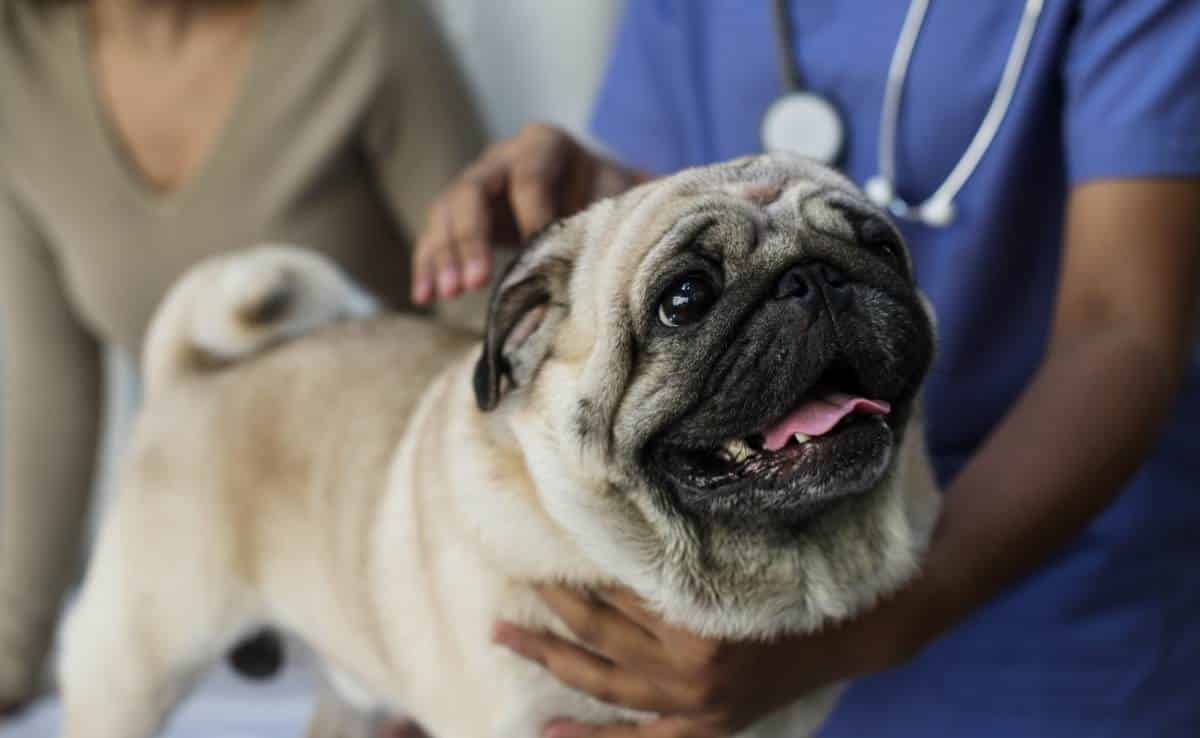
If your dog is acting strangely or experiencing minor symptoms of weakness, lack of coordination, vomiting, diarrhea, etc., and you think he may have consumed something he shouldn’t have, seek a veterinarian’s attention immediately. If you wait too long, your dog could become gravely ill.
What If You Can’t Reach Your Veterinarian?
In an emergency, when you cannot reach your veterinarian, immediately contact your local animal emergency clinic or call one of these hotlines to speak to a toxicology specialist and vets who can assist 24/7.
- Pet Poison Helpline at 1-855-764-7661
- North Shore America / ASPCA Hotline at 1-888-232-8870
- ASPCA Animal Poison Control Center at 1-888-426-4435
Note: They may charge a small fee of $59 to $75 per incident and ask for age, weight, medical history of your pet, concern details, amount, when it happened, and current symptoms.
Ask A Vet

Try using our “Ask a Vet” chat feature that is available 24/7 (see the lower right-hand corner of your browser window). You’ll get answers from a doctor within minutes.
Depending on what your dog ate and how long it’s been since they ate it, your veterinarian may induce your dog to vomit. If the item is likely to cause further damage to your dog on the way back up, your veterinarian will not induce vomiting. In this case, other methods of helping your dog will be discussed, such as having your dog ingest something to bind with the offending food and neutralize it. Another option might be to perform surgery and remove it.
Be Proactive & Save Yourself From Expensive Vet Bills
If your dog eats something and gets sick, the vet bill can be tough for pet parents to stomach. Take the proactive step and consider pet insurance (we compare top pet insurance companies in our comparison) before you find yourself rushing to the vet. That way, if an unsuspecting treat becomes a medical emergency, your dog (and your wallet) will be better off. Check out this video explaining what pet insurance is and why it’s worth it.
